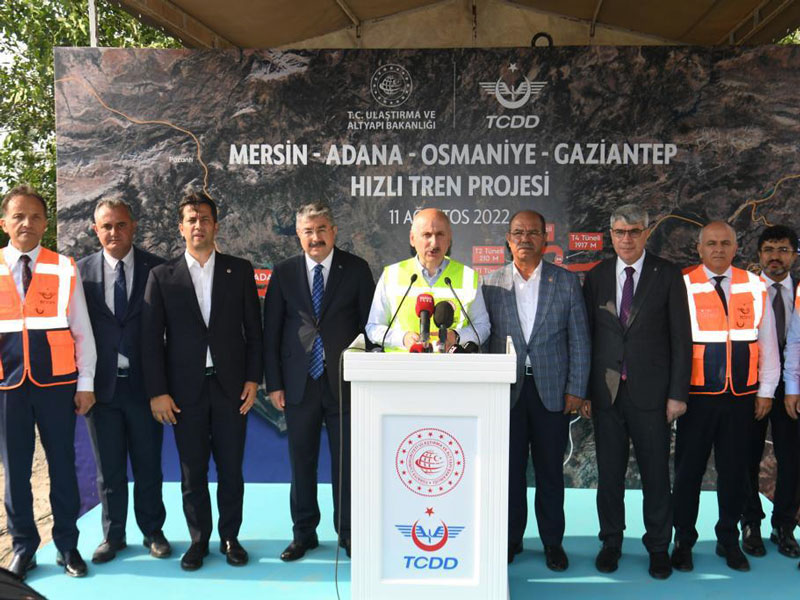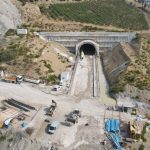 Adil Karaismailoğlu, the Transport Minister of Turkey announced that the 295 km Mersin – Gaziantep high-speed rail crossing through Adana and Osmaniye will be opened in 2025.
Adil Karaismailoğlu, the Transport Minister of Turkey announced that the 295 km Mersin – Gaziantep high-speed rail crossing through Adana and Osmaniye will be opened in 2025.
The announcement was made during a technical visit at the construction site in Osmaniye, southern Turkey, where together with the general Manager of TCDD Hasan Pezük inspected the tunnel construction site which connects the Toprakkale and Bahçe stations along the new railway line.
“We have accelerated the rail investments in Osmaniye for projects comprising track renewal on the conventional network and we will continue to implement the Mersin – Gaziantep high-speed rail connection and to provide high-speed train access to Osmaniye by 2025,” the minister said.
To improve and develop the transport infrastructure in Osmaniye, the Turkish government invested TRY 3.75 billion (USD 210 million), with TRY 2 billion (USD 111.34 million) provided for the rail expansion in the region. These investments supported the projects on the Yenice-Fevzipaşa-Narlı railway line, the renewal of 55 km of rails between Taşoluk-Fevzipaşa-Beyoğlu and the reconstruction of a 46 km section between Iskenderun and Toprakkale. Feasibility studies have been also completed for the construction of a rail junction to provide connection to the to the Industrial Facilities, Yumurtalik Free Zone industrial centres and ports in Çukurova Region and Iskenderun Bay. Following the implementation of the projects, Osmaniye region benefits a 74 km long rail system within its provincial borders.
The Mersin – Adana – Osmaniye – Gaziantep high-speed double-track electrified railway line is suitable for speeds of up to 200 km/h connecting Mediterranean and Southeastern Anatolia regions. Due to its complexity, the works on the new line are carried out on six sections.
The line will have 32 tunnels totalling 16.5 km, six bridges and viaducts totalling 602 metres as well as 30 underpasses and overpasses. TCDD achieved a physical progress of 56% of the infrastructure works of the 13-km tunnels on the route.
The new line between Mersin and Gaziantep will be cut by 66 km from 361 km to 295 km reducing the travel time by four hours, from currently 6h23min to only 2 hours. With the completion of the project, the travel time between Adana and Osmaniye is cut by half, to 40 minutes (from currently 80 minutes).
The infrastructure of the remaining 45 km route and the superstructure, electric, signalling and telecommunication works of the entire line will be completed in time. “We plan to complete our line in 2025 and put it into commercial operation,” the minister underlined.
Turkey intends to become the 6th country in Europe in terms of the length of the high-speed network which is expected to be increased to over 13,000 km of railways.
“Our country, located in the Middle Corridor of the Iron Silk Road between Asia and Europe, from China to London, is a center for international freight and passenger transport. The investment we made for the development of our country’s railways is of great strategic importance,” Minister Karaismailoğlu said.
Since 2003, Turkey has expanded its rail network to 13,500 km from 10,960 km and is continuing the construction of 4,693 km of conventional and high-speed railways. In addition, the authorities are planning tenders and design work for a total of 13,978 km of lines.
Recently, construction work started on the 142 high-speed railway line linking Yerköy and Kayseri which will reduce the travel time by two hours.
The minister considers that through the transformation of the rail system, it has “solved the infrastructure problem” which was poor and with low performance. Large projects have been completed covering the Marmaray, Eurasia Tunnel, Istanbul Airport, Baku-Tbilisi-Kars railway corridor, as well as other highway routes.
According to the 2053 Transport and Logistics Master Plan, Turkey will increase the share of rail passenger transport from 1% to 6.2%, while the rail freight share will increase to 22%, from currently 5%. In addition, the authorities will implement projects and measures to provide high-speed train connections to more provinces. In this context, the plan includes high-speed rail links to 52 provinces from 8 and the annual passenger transport will increase from 19.5 million to 270 million. The annual freight transport will reach 448 million tonnes from 55 million tonnes. “We will create a safe, fast, efficient and effective railway infrastructure and we plan for 35% of the total energy needed by the railways to come from renewable resources,” the minister concluded.
Share on:







